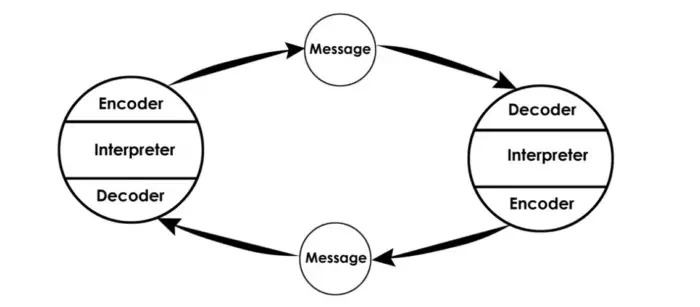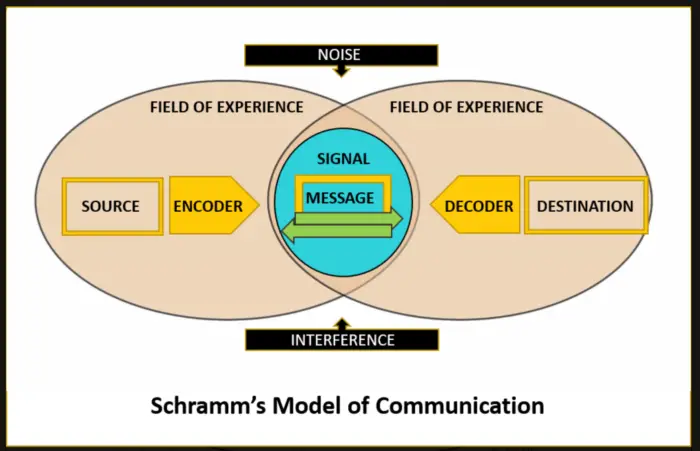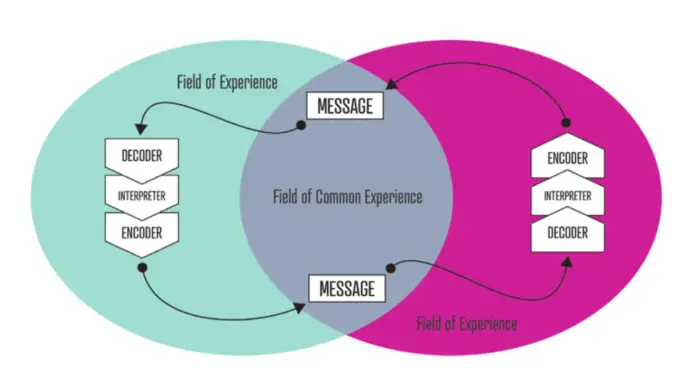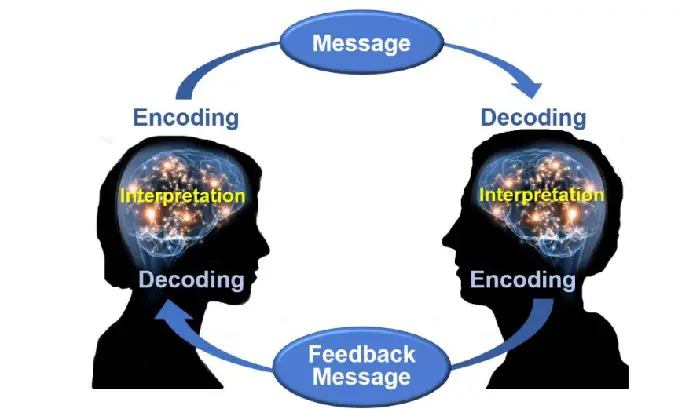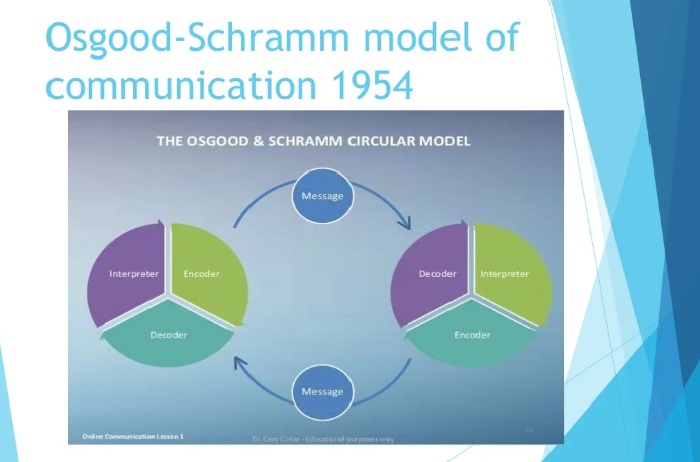Achieving organizational goals depends heavily on effective communication. Effective communication plays a part in any organization from when a new employee starts working there. For an employee to function effectively, it is the human resources department’s priority to adequately explain the organization’s regulations and procedures to him.
The Wilbur Schramm Model of Communication was suggested to explain the flow of communication effectively. Wilbur Schramm proposed it as a communication model that emphasizes the interactive nature of communication. It highlights the importance of feedback and the mutual exchange of information between the sender and receiver.
The essential elements, applications, limitations, and Schramm’s Model of Communication Example will be discussed briefly in this article.
What is Schramm’s Model of Communication?
This framework is often known as the communication Osgood-Schramm model. In contrast to other communication models, this one is circular or cyclical and includes all of the fundamental components of communication. When Schramm’s Model of Communication was put forth in 1954, the Shannon-Weaver model served as its inspiration.
Charles Osgood initially put it out. His initial hypothesis was that communication follows a circular rather than a linear model. W.Schramm later modified this concept and wrote about it in his book.
This model employs a traditional method to describe the flow of communication, implying that communication is a continuous two-way exchange of messages between sender and recipient.
This strategy is based on the notion that the sender and the recipient must understand the message. For instance, a group of second-grade pupils won’t be able to understand past participle tense from an art professor.
See Also: Business Communication
How does Schramm’s Model of Communication work?
The Encoder or Carrier, Decoder or Listener, Interpreter, and Message are components of the Schramm communication model. According to this concept, information travels in both directions between the sender and the recipient during communication. The message is sent from the sender to the Receiver, but one model component claims that when the Receiver sends a message back to the sender, the roles are switched. Both the transmitter and the recipient switch roles.
The recipient typically tries to understand what the sender is attempting to say when information is sent. The whole method of communication is useless if the recipient cannot understand or decode the sender’s message.
Decoding and encoding are, therefore, two essential components of good communication. The paradigm states that sending a message is only half-completed until receiving feedback from the recipient. In the past, communication would stop when the recipient received the information, and the flow of communication was unidirectional.
In contrast, this concept is built on a two-way communication process in which the roles of the sender and Receiver are switched back and forth. According to Schramm, who was adamant about communication being a two-way process.
Contrary to Berlo’s Communication model, this communication model lacks the fourth component. The sender encrypts, creates the message, and then sent to the recipient. The message is decoded and comprehended by this recipient. Then, switching roles, the Receiver encrypts an acceptable reply and transmits it back to the sender, who is now the recipient.
The characteristics of Schramm’s Model of Communication
Source
The sender is referred to as the message’s source because he creates and transmits the message to the recipient. The sender’s responsible for ensuring that the communication is legible, clear, and easy to grasp by the recipient.
Receiver
The individual to whom messages are sent is known as the Receiver, while the Receiver is frequently referred to as the message decoder. It is crucial to consider several factors to ensure the recipient can decipher the message.
Message
The message, which might be written, audio, video, or a combination of all three, is the communication’s central idea. The communication sent from the sender to the Receiver is the message.
Feedback
Feedback occurs when the sender and Receiver start exchanging information based on the input they received. The sender needs to determine whether the recipient has correctly absorbed the information.
Semantic Disruption
Because of the noise, the recipient may not understand the sender’s intended intent when sending messages. Noise also has the potential to change the meaning of the message.
Perks of Schramm’s Model of Communication
- Dynamic models: Demonstrate how circumstances may vary.
- It demonstrates why redundancy is crucial.
- Assume that all forms of communication are circular.
- Feedback is a crucial component. The sender can also determine whether the communication was as intended by asking the recipient.
Drawbacks of Schramm’s Model of Communication
- Cannot handle sophisticated communication procedures. This model does not account for many senders or receivers or the possibility of a multi-step communication process.
- It doesn’t consider the possibility of unequal communication; this model frequently fails in scenarios involving power differentials. This paradigm does a poor job of explaining how power works in communication in general.
Schramm’s Model of Communication Example
We have mentioned Schramm’s Model of Communication Example below to understand the model’s basic concept better. You can easily be familiar with the practical application of this concept once you go through Schramm’s Model of Communication Example. So have a look;
Example 1
“I always get late for my work; please bring me a clock,” John says to Teddy.
After Teddy bought him a clock at a nearby market, John was never late for work again. How could he have misinterpreted the message if he could comprehend his friend’s desire? Whether Teddy or anyone else has to provide a clock, a clock remains a clock.
A clock is never mistaken for a wristwatch or anything else. Some messages apply to almost everyone. They are known as messages with a denotative meaning because they have a context that is essentially the same for everyone, eliminating the possibility of confusion and misunderstanding.
Example 2
“Will you accompany me to see a movie?” Jennifer asks Sam.
Sam remained silent and did not answer, so contact between Sam and Jennifer was not fully established. Sam could have answered or informed Jennifer of his disinterest if he had not been interested in the movie. According to Schramm’s concept, it is the recipient’s job to provide feedback as soon as the information reaches him.
He must clarify everything with the speaker if he is unclear about it or has any reservations. Because of this, anytime the speaker conveys any message to the listener, the latter decodes the message, comprehends it, and then relays it back to the speaker, completing the cycle.
Prompts regarding the Communication Osgood-Schramm Model
Examine the prompts by the following points:
Essay Prompt
Write a three to four-paragraph essay defining the Osgood-Schramm model of communication and outlining the contributions of Wilbur Schramm and Charles Egerton Osgood to the study of communication.
Example: The concept of the “field of experience” was the inclusion of Wilbur Schramm in Charles Osgood’s theory.
Graphic Organizer Prompt 1
Create a graphic organizer that lists the components of the Osgood-Schramm communication model, such as a chart, poster, or other visual aid.
Example: The conversation’s message is its subject matter.
Graphic Organizer Prompt 2
List the benefits and drawbacks of using the Osgood-Schram communication model in a poster, chart, or other graphic organizer.
Example: This model’s limitation of only considering one-on-one communication precludes consideration of communication involving multiple senders and various receivers.
Scenario Prompt
Write a one- to two-page essay describing a situation that exemplifies the Osgood-Schramm Model of Communication and how semantic barriers can affect it. You can create a hypothetical situation or use one from your own experience.
Example: Barry spent two hours stuck in traffic on his way home from work. When he eventually arrived home, When Tracy saw him. She was ecstatic and welcomed him with an enthusiastic “Hey, honey!” Still upset from being stuck in traffic, Barry responded, “Aw, shut up.”
How long ago was the Osgood-Schramm model developed?
Charles E. Osgood first proposed that communication must take place in 1954, which is when Schramm’s model first emerged. Osgood was a psychologist born in America and worked as a research assistant for US Navy and Air Force. He is recognized for his method, which is the semantic differential. His method is to analyze the attitudes, prejudices, and perceptions of others.
Wilbur Schramm built upon Osgood’s ideas. Communication expert Schramm significantly influenced the field of mass communication. He received a Ph.D. in American literature from the University of Iowa in 1932. He began studying the impact of mass media on public opinion when the Second World War began.
Schramm refined Osgood’s theory to produce a model to show how communication is cyclical, with the sender and the receiver exchanging messages. Furthermore, according to Schramm, effective communication requires both the sender and the recipient to understand each other’s messages.
Furthermore, a message may only be adequately understood and fully communicated if the recipient provides feedback. Misunderstandings prevent the two parties from communicating effectively.
Key takeaways
Take a quick look at the key takeaways:
- According to the Schramm communication paradigm, communication occurs between an encoder and a decoder in a two-way, circular process. Wilbur Schramm developed it in 1954, drawing inspiration from Charles Osgood’s work as a psychologist.
- The Schramm communication model describes communication as a two-way exchange of messages between sender and recipient. Information flow is continuous and cyclical as long as signals are appropriately interpreted during each cycle.
- Five elements of the Schramm communication model contribute to an explanation of communication. These are the sender, the recipient, the message, the feedback, and the semantic noise.
FAQ
What features does the Osgood-Schramm model have?
In this type of communication, as opposed to linear communication, the transmitter and the Receiver interact circularly. The procedure is finished when the transmitter and the Receiver switch roles and provide feedback to one another. The model includes a sender who is the message's source and a receiver who decodes it, among other things. The message is the result of two devices interacting as sender and Receiver. The message a recipient sends back to the sender is known as feedback, which is the last form of communication.
What distinguishes the Osgood-Schramm model from the other communication models?
According to Schramm's approach, communication happens in loops. Being circular suggests that the sender and the recipient have equal responsibility and participation in the communication process. This sets it apart from previous models that consider communication to be linear.
Conclusion
There are several communication models, and this model is more practically valid. We have deeply explained the Schramm model of communication, including the benefits and limitations of this model comprises. You can acknowledge this model better through a Schramm Model of Communication Example.
See also: What is Conversational Marketing? 101 Guide


